Agricultural and Biological Research
RNI # 24/103/2012-R1
Research Article - (2023) Volume 39, Issue 3
Understanding the ingestive behavior and daily voluntary intake of grazing livestock is important for sustainable land use and management of pasturelands. Since the 1990s, Inner Mongolia has completely converted from old nomadic grazing to settled grazing, and many small fences have been built around settled areas, where livestock are placed inside the fences and grazed. Currently, desertification of grasslands is progressing in a mosaic pattern around the fence. There have been few quantitative studies of individual sheep foraging behavior in confined spaces and changes in plant community composition associated with foraging. The study was conducted in Abag Banner (an administrative unit of China equivalent to a county), located in the northern part of the Xilingol Autonomous Region of Inner Mongolia, which borders Mongolia. This study aimed to quantitatively evaluate the impact of livestock ingestive behavior on pasture vegetation in the sedentary grazing area of Inner Mongolia and to provide basic data for the sustainable use of pastureland. Three sites were established in a sedentary grazing area, where tethering grazing experiments (hemp rope length of 6 m) were conducted. Quadrats of 1 × 1 m were established inside (four quadrats) and outside (five quadrats) each site for the vegetation survey, and plant species identification, plant height, vegetation cover, and soil hardness were evaluated. Livestock (sheep) instinctively selected and fed on high-palatability plants instantaneously after the start of the tethering grazing experiment. The increased grazing intensity over 5 days and the grazing of high-palatability plants decreased plant height and aboveground biomass; however, the botanical composition remained unchanged. The Shannon diversity index value decreased from 1.97 to 1.60 on day 4, and the vegetation cover decreased from approximately 80% to <10%. For aboveground biomass, only 15%-54% remained. Salsola collina Pall. and Caragana microphylla Pall. shrubs, which had low aboveground biomass from the start, were barely grazed, whereas Agropyron cristatum L., with high palatability, was left with only 15% biomass. The soil hardness increased by 1.25 and 0.25 mm at sites A and B, respectively, and decreased by 0.63 mm at site C. This indicated that the soil was locally bare, and the topsoil was destroyed.
Sedentary grazing; Pasturelands; Desertification; Tethering grazing experiment; Topsoil loss
Since the 1990s, Inner Mongolia has completely converted from old nomadic grazing to settled grazing, and many small fences have been built around settled areas, where livestock are placed inside the fences and grazed [1-10]. In China, ownership of land is held by the state, while land use rights are granted to individuals for a certain period of time, allowing them to buy and sell their land. In the grasslands of the Inner Mongolia Autonomous Region, pastoralists built various fences to protect their allotted land [2-7]. Currently, desertification of grasslands is progressing in a mosaic pattern around the fence. There have been few quantitative studies of individual sheep foraging behavior in confined spaces and changes in plant community composition associated with foraging [3,11-15]. Livestock grazing brings many changes to pasturelands [1,16-32]. Among them, grazing alters the composition of plant communities and the diversity of plant species, and overgrazing can lead to further land degeneration and desertification. Many studies have focused on the effects of grazing on the plant community and plant species diversity of pasturelands. Quantitative studies of livestock behavior, especially in narrow fences, are scarce [33-51]. Therefore, for sustainable grazing management of pastureland ecosystems, quantification of livestock behavior patterns and feeding habits and understanding livestock utilization of pastureland plant resources are necessary.
Understanding the ingestive behavior and daily voluntary intake of grazing livestock, such as sheep and goats, is important for sustainable land use and management of pasturelands, as well as the prevention of pastureland degradation and desertification. Sheep grazing management requires a reasonably large pastureland area and adequate forage and water resources. Theoretically, an adult sheep consumes 8-12 kg of grass per day, a growing sheep consumes 6-8 kg, and a lamb consumes 3-5 kg [52-56]. In Japan, if grazing were the only management method for half a year, approximately 0.5 Â hectares of pastureland would be needed per 10 adult sheep (©2005 Japan Livestock Industry Association All Rights Reserved). In Inner Mongolia, where rainfall and plant productivity are much lower than in Japan, the pastureland was already overgrazed even though the pastureland area per sheep was 0.99 hectares in 2005, and grazing livestock behavior and pastureland use were investigated by attaching GPS to several grazing animals in a herd [9,55-63]. However, the study failed to determine whether the number of days per unit area could sustain the continuous grazing of sheep. In this study, we used the biologging method proposed by Kawata et al., [36,37] to determine the daily voluntary intake and ingestive behavior of sheep and the number of days the sheep could graze on pastureland within reach of a hemp rope tether.
As noted above, with the transition from nomadic life to agricultural settlements in the Inner Mongolia Autonomous Region in the 1990s, open grazing, which allows livestock animals to roam and forage freely, is no longer possible. Instead, their behaviors must be restricted to narrow confines or spaces between fences. However, in fenced pastureland, livestock animals frequently and repeatedly graze in the same areas, increasing grazing pressure per unit area and leading to pastureland degeneration, mainly in areas near watering troughs, shelters, and fences [2-6]. Although several studies on the effects of repeated use of small areas of pastureland by livestock on the species composition of plant communities, aboveground biomass, and soils are prevalent, few quantitative studies have been conducted in settled areas of Inner Mongolia [1-10, 13-15,25,27,29-33,36-39,45-50,52-69]. In this study, we conducted a tethering grazing experiment using the biologging method in an area inside the fenced pastureland of a settled pastoralist in Abag Banner (an administrative unit of China equivalent to a county), located in the northern part of the Xilingol Autonomous Region of Inner Mongolia, which borders Mongolia. In this case study, we aimed to provide basic data on the sustainable use of pastureland associated with the foraging behavior of domestic animals. Therefore, we attached GPS loggers to sheep to record detailed ingestive behavior as point data and estimated the sheep’s voluntary intake through visual assessment of the changes in plant height, vegetation cover, aboveground biomass, diversity, and soil hardness in the morning and afternoon at fixed quadrat locations.
Study area
The study was conducted in Abag Banner of the Xilingol Autonomous Region of Inner Mongolia, China. Abag Banner is located in the northern part of the Xilingol Autonomous Region of Inner Mongolia, which borders Mongolia. The range is 113°27′ to 116°11′ east and 43°04′ to 45°26′ north, and the total land area is 2.75 million hectares, of which 98% is pastureland. The northern part of Abag Banner is hilly, with an average elevation of 1,127 m. It is located at the southern edge of the Mongolian Plateau and has a topographically high elevation in the north and a low elevation in the south. The average annual precipitation from 1960 to 2015 ranged from 130.9 to 431.8 mm, with an average precipitation of 244.7 mm. The minimum temperature is -42.2°C, and the maximum is 38.6°C. According to the Bureau of Statistics of Abag Banner, the population of Abag Banner in 2019 was approximately 4,3500, of which pastoralists accounted for 2,3500. The study area was in the southwestern part of Abag Banner, where the typical pastureland steppe of the Mongolian Plateau can be found. The soil is sandy clay loam with a topsoil layer approximately 10 cm thick (Figure 1). The field experiment in this study was conducted between August 1, 2015, and August 15, 2015.
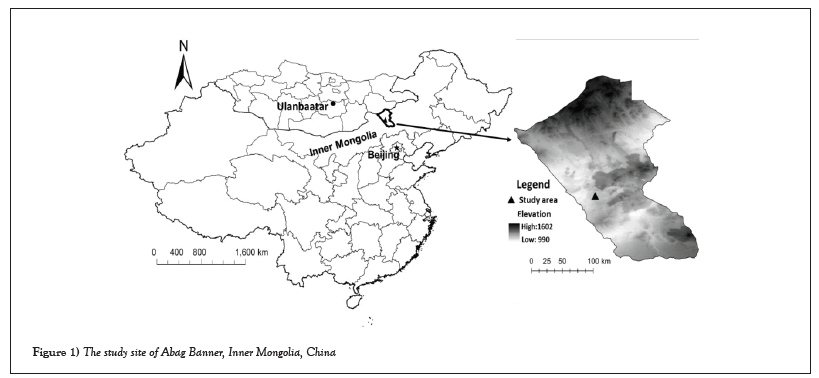
Figure 1: The study site of Abag Banner, Inner Mongolia, China.
When the number of livestock animals in the Xilingol Autonomous Region of Inner Mongolia peaked in 1999, the implementation of China’s ‘Conversion of Cropland to Forest Program,’ also known as ‘Grain for Green,’ resulted in a drastic decrease in the number of livestock animals. Figure 2 shows the changes in the number of livestock over the years based on the livestock statistics published by the Bureau of Statistics of Abag Banner. The number of sheep was the highest among the five livestock species (sheep, goats, cattle, horses, and camels) in Abag Banner. In contrast, the number of large livestock (horses, cattle, and camels) did not change considerably from 1979 to 2007, whereas the number of small livestock (sheep and goats) increased fivefold in 29 years from 0.12 head per ha in 1978 to 0.64 head per ha in 2007 (Bureau of Statistics of Abag Banner) (Figure 2).
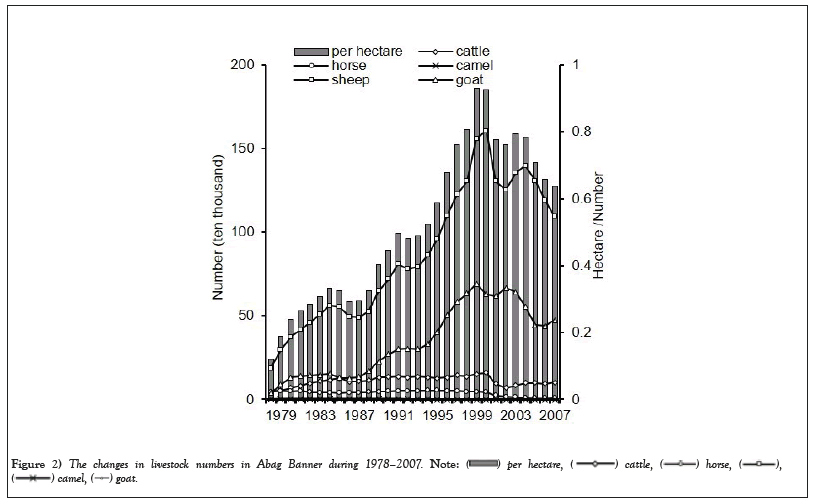
Figure 2: The changes in livestock numbers in Abag Banner during 1978–2007. 

Data collection
In the Inner Mongolia Autonomous Region, an increase in livestock has led to overgrazing, which has devastated pastureland [2-7,13-15,29-33,36-39,45-50,64-67]. However, the overgrazing of pastureland in Mongolia is controlled to a certain extent by nomadism [10,55,56,60,61]. Biologging is the practice of attaching devices to animals (including livestock) and recording their activity and movements to generate information about their habitat environments. The term “biologging” originated in Japan and was coined at the first International Bio-Logging Symposium in Tokyo in 2003 [34,36,37,70]. Biologging was defined at the symposium as the “investigation of phenomena in or around free-ranging organisms that are beyond the boundary of our visibility or experience” [17].
Kawada et al., [36,37] proposed the design of “biologging” in “Resource selection analysis using biologging in Mongolian Pasturelands” and conducted a demonstration experiment in the Mongolian nomadic grazing pastureland with recording cameras attached to livestock. This study was conducted by attaching GPS collars to livestock in a sedentary grazing area, recording their behavior, and then monitoring the foraging behavior by visual observation. The tethering grazing experiment was conducted inside the fence of a former nomad (referred to here as Mr. A) who settled in Abag Banner of Inner Mongolia. In the early 1990s, Mr. A established a fence on the land near the house that he obtained and kept his livestock inside the fence. The sale of raised sheep became the main source of income for Mr. A and his family. The pastureland area is approximately 267 ha and is entirely surrounded by iron fences. The livestock drank water from a well with an installed electric automatic water pump. The water pump was automatically turned on whenever the livestock drank water. Mr. A owned 470 livestock animals, of which 420 were sheep (180 lambs, 210 ewes, and 30 rams), 45 were goats (20 kids, 24 does, and 1 buck), and five were cows.
We conducted a tethering grazing experiment with the three largest 4-year-old ewes in the herd (weighing 51, 46 and 41 kg) and fitted them with GPS data loggers (collars). Three study sites (A, B, and C) were established in pastureland inside the fence. Each ewe was secured to an anchor point at each site with a hemp rope 6 m in length (radius); hence, the estimated roaming area for each ewe was 113.097 m2. The GPS was set to record data that included longitude, latitude, and time in 10-second intervals. We also extracted and mapped point density from GPS point data using geographic information system (GIS) methods and normalized the temporal data of the sheep’s sojourn times extracted from the GPS records to values between 0 and 1, where the value 0 represents the shortest sojourn time, and the value 1 represents the longest sojourn time. To acclimate the selected sheep to tethering grazing, they were pretrained for 4 days in a separate area near the experimental sites.
Estimation of aboveground biomass
To determine the changes in aboveground biomass due to grazing, we randomly established five 1 × 1 m vegetation survey quadrats outside (around) the site. In each quadrat, we identified the plant species and measured the vegetation cover and plant height of each species. The aboveground parts of each species were cut and dried naturally. The dry weight of the plants was used as the Dry Matter Production (DMP). The cover of each plant species was multiplied by its respective height, and the resulting value was used as the plant volume [71]. The formula for calculating plant volume (cm3) is shown below, and the results are shown in Figure 3. Vegetation cover was used to determine the total coverage (in percentage) of each species in the 1 m2 quadrat. The height of all plant species that appeared in each quadrat was measured three times, and the average value was taken as the plant height (Figure 3) [71].
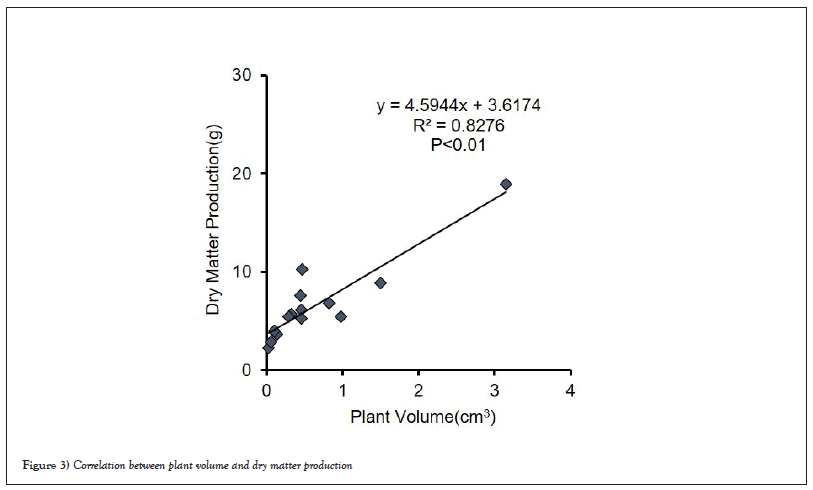
Figure 3: Correlation between plant volume and dry matter production.
Plant volume (cm3)=(plant cover (cm2) × plant height (cm), (1)
As shown in Figure 3, the correlation between the average plant volume (x-axis) and the average dry matter productivity (y-axis) obtained outside the tethering grazing experimental sites was significant and complied with equation (2):

Because it was impossible to harvest plants at the sites during the tethering grazing experiment, four 1 × 1 m fixed-point quadrats were set up at each site. Vegetation surveys (species identification and measurement of plant height and vegetation cover) were conducted twice daily (at 6:00 AM and 6:00 PM) in each quadrat. The first set of data collected from the vegetation surveys of all quadrats on the first day of the experiment, at 6:00 AM, was used as the initial value. The vegetation surveys were repeated for five consecutive days to identify vegetation changes resulting from sheep foraging. At the end of the experiment, after the last vegetation survey was conducted at 6:00 PM on day 5, all aboveground parts of each species in all quadrats at the site were harvested, dried naturally, and weighed. The resulting value was divided by the weight at the start of the experiment to determine the remaining aboveground biomass (survival rate) per species.
Changes in plant species diversity owing to sheep foraging
We applied the Shannon diversity index (H’) and Pielou’s evenness index (J) to identify how plant species diversity changes with livestock grazing. The formulas for the Shannon diversity index (H’) and Pielou’s evenness index (J) are shown in equations (3) and (4) below [72,73].


where Pi=ni/N, Pi is the ratio of the number of individuals of the ith species to the total number of individuals, N. S is the number of species in a given plant community, and ln is the natural logarithm. The relative dominance of each species in the plant community within a site was calculated and ranked.
Defining the palatability of plants to sheep
The term ‘palatability of plants to livestock’ has various definitions. However, in this study, we defined the palatability of plants to livestock based on a study by Yokohama et al., [59]. They divided palatability into four levels, a, b, c, and d, each representing high palatability, relatively high palatability, relatively low palatability, and low palatability, respectively (Table 1). This study used two plant species, needlegrass (Stipa krylovii Roshev.) and crested wheatgrass (Agropyron cristatum L.), as the high palatability food for sheep to demonstrate that grass is more palatable to livestock.
| Species name | Plant height before grazing (cm) | Estimated Percentage of Biomass before grazing (%) | Estimated Biomass before grazing (g) | Estimated Biomass after grazing (g) | Survival rate (%) | Pi=Ni/N | Palatability | Ranking (Pi) |
|---|---|---|---|---|---|---|---|---|
| Stipa krylovii Roshev. | 34 | 13.5 | 13.8 | 5.66 | 41% | 0.207 | a | 1 |
| Convolvulus ammanii Desr. | 5 | 17 | 17.4 | 4.83 | 28% | 0.176 | b | 2 |
| Carex duriuscula C.A.Mey | 8 | 7.8 | 8.02 | 2.53 | 32% | 0.146 | a | 3 |
| Agropyron cristatum L. | 24 | 16.1 | 16.4 | 2.41 | 15% | 0.117 | a | 4 |
| Artemisia frigida Willd. | 8 | 8.8 | 8.94 | 3.57 | 40% | 0.091 | a | 5 |
| Allium mongolicum Regel | 14 | 11.7 | 11.9 | 3.85 | 32% | 0.088 | a | 6 |
| Chenopodium serotinum L. | 3 | 6.6 | 6.4 | 3.21 | 50% | 0.044 | d | 7 |
| Salsola collina Pall. | 3 | 4.4 | 4.4 | 2.36 | 54% | 0.042 | c | 8 |
| Cleistogenes squarrosa Keng | 8 | 3.5 | 3.6 | 1.52 | 42% | 0.017 | b | 9 |
| Caragana microphylla Pall. | 12 | 10.7 | 10.9 | 5.58 | 51% | 0.017 | c | 10 |
Note: Where Palatability of plants to sheep: a-high palatability; b-relatively high palatability; c-relatively low palatability; d-low palatability, respectively Pi:Proportion of individuals of i species in a whole community, Ni:individuals of a given type/species, N:total number of individuals in a community.
Table 1: Impact of tethering grazing experiments on plant species of differing palatability.
All five livestock species highly preferred the flowering plants, fringed sagebrush (Artmisia frigida Willd.) and Mongolian onion (Allium mongolicum Regel). Spikeletrush sedge (Carex duriuscula C.A. Mey) was highly preferred by sheep, goats, and horses, and the perennial true grass Diplachne (Cleistogenes squarrosa Keng) and perennial herb bindweeds Sedergene (Convolvulus ammanii Desr.) were preferred by sheep (level b). The leguminous pea shrub Caragana (Caragana microphylla Pall.) and annual herb slender Russian thistle/saltwort (Salsola collina Pall.) had palatability level c for sheep and figleaf goosefoot (Chenopodium serotinum L.) had palatability level d.
Soil survey
Soil physical properties are closely related to grazing pressure and are not as sensitive to vegetation changes. However, Wu et al., [10] implied that recent excessive livestock grazing might affect the soil’s physical properties and lead to the degradation of pastureland ecosystems. Therefore, to identify the effects of sedentary grazing, we measured soil moisture (©HydroSenseTM) and soil hardness (©Yamanaka type hardness meter) twice per day (6 AM and 6 PM) at sites A, B, and C. In addition, the effects of sedentary tethering grazing on soil moisture and soil hardness of the pastureland were tested in a 5-day experiment.
Changes in botanical composition within the sites owing to grazing
The total number of plant species that appeared at the three sites was 17, representing eight families and 15 genera. Among them were 15 species of perennial plants and two species of annual plants. The Leguminosae family had four species, and the Poaceae and Asteraceae families each contained three species. Changes in aboveground biomass, survival rate, relative dominance, palatability of plants, and the top 10 dominant species at the site before and after the sheep grazed over 5 days are shown in Table 1. In descending order, the top 10 dominant species were S. krylovii Rosev., C. ammanii Desr., C. duriuscula C.A. Mey, A. cristatum L., A. mongolicum Regel, C. serotinum L., S. collina Pall., C. squarrosa Keng, and C. microphylla Pall. At the end of the experiment, the species with high palatability, A. cristatum L., had a survival rate of 15%, whereas C. duriuscula C.A. Mey and A. mongolicum Regel had a survival rate of only 32%. The species with relatively low palatability, S. collina Pall. and C. microphylla Pall., and the species with low palatability, C. serotinum L., had at least 50% survival rates (Table 1).
Figure 4 shows the changes in plant height of each species at the sites. The species with the highest mean height at the sites was S. krylovii Roshev., with a mean height of 34 cm on day 1, whereas the mean height of the other species ranged from 3 to 16 cm. The mean height of species with high palatability, such as S. krylovii Roshev., A. cristatum L., A. mongolicum Pall., and C. duriuscula C.A.Mey., decreased daily. After five days, the mean heights were reduced by 21, 24, 12 and 6 cm, respectively. Conversely, the species with low and relatively low palatability, C. serotinum L., S. collina Pall., and C. microphylla Pall., showed no change in mean height, even on day 4. Only on day 5 were their mean heights reduced by 2, 1, and 10 cm. S. collina Pall. had the smallest change in mean height because of the alternate leaf arrangement on its many woody branches (Figure 4).
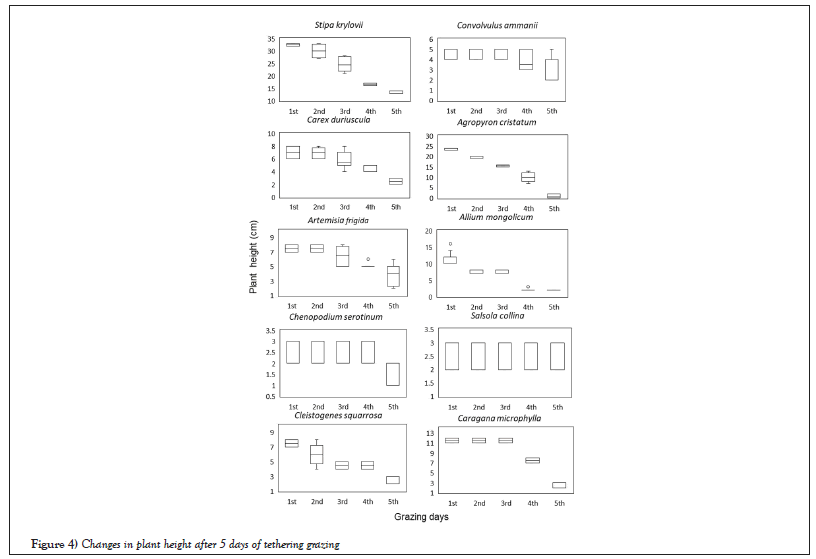
Figure 4: Changes in plant height after 5 days of tethering grazing.
Figure 5 shows a summary of the 5-day voluntary intake of sheep in the five-point quadrats estimated using equation (2) according to the plant species. The voluntary intake of the three sheep on day 1 was low, at only 7.5 g. However, they increased their voluntary intake later by approximately one-fold on days 2 and 3 to 14.2 and 13.8 g, respectively. Day 4 had the highest sheep grazing, with 16.3 g, possibly because they were hungry and acclimated to tethering grazing. Day 5 had a voluntary intake of 14.4 g. A. mongolicum Regel, a species with high palatability, was ranked sixth in terms of species dominance, but it was the most eaten species on day 1, with approximately 2.09 g consumed, followed by C. duriuscula C.A. Mey, with 1.35 g. Over the 5 days, the species with the highest relative voluntary intake was A. cristatum L., whereas the species with the highest absolute voluntary intake was the dominant species, S. krylovii Rosev (Figure 5).
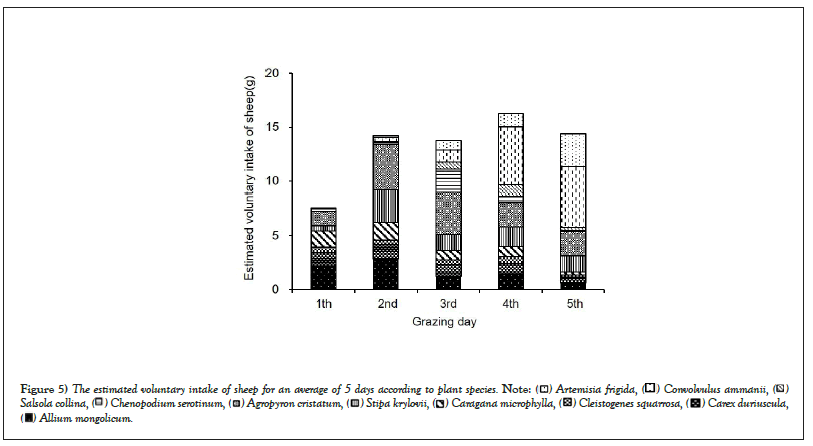
Figure 5: The estimated voluntary intake of sheep for an average of 5 days according to plant species. 


Changes in species diversity of plant communities owing to grazing
The number of species at the sites remained almost the same, even though grazing pressure increased with tethering. Therefore, plant species diversity was affected by the evenness index. The Shannon diversity index (H’) remained unchanged until day 3 after the start of grazing; however, from day 4, Pielou’s evenness index (J) decreased from 0.82 to 0.70, and the Shannon diversity index decreased from 1.97 to 1.60. The decrease in the Shannon diversity index (H’) implied that the reduction in high palatability species such as A. mongolicum Regel, C. duriuscula C.A. Mey, and A. cristatum L. as a result of sheep forage selection reduced the species evenness of the plant community (refer to Table 1 and Figure 6). The average vegetation cover in the quadrats within the three sites before the start of the experiment was 40%; however, this percentage decreased to 13.87% on day 5 (Figure 6).
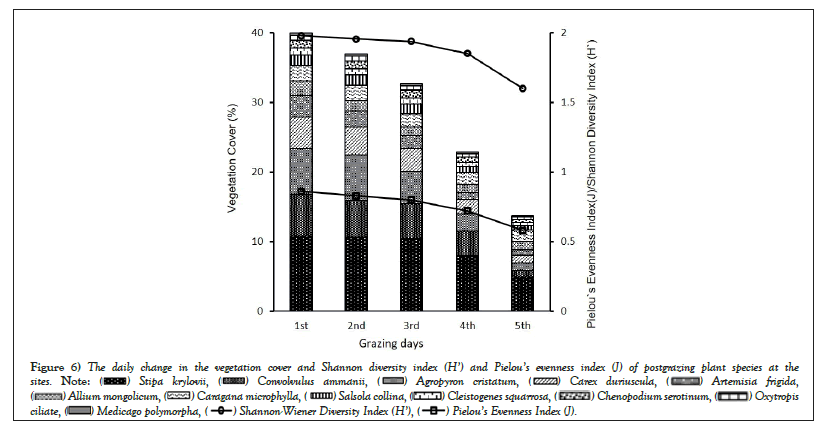
Figure 6: The daily change in the vegetation cover and Shannon diversity index (H’) and Pielou’s evenness index (J) of postgrazing plant species at the
sites. 


Ingestive behavior of the tethered sheep
The point density data recorded by GPS showed detailed ingestive behavior and sojourn times of sheep over 5 days (Figure 7). On day 1 of the study, the three selected sheep faced and approached each other as closely as possible. They also stayed at the same spot for a longer period. On days 2 and 3, although they grazed at similar spots, they moved in irregular patterns, and the time they stayed at the same spot became shorter. On day 4, even though the sheep spent much time at the same spot, they moved and grazed as long as the length of the rope allowed them to reach throughout the site. However, on day 5, they moved in a pattern similar to that of the first day.
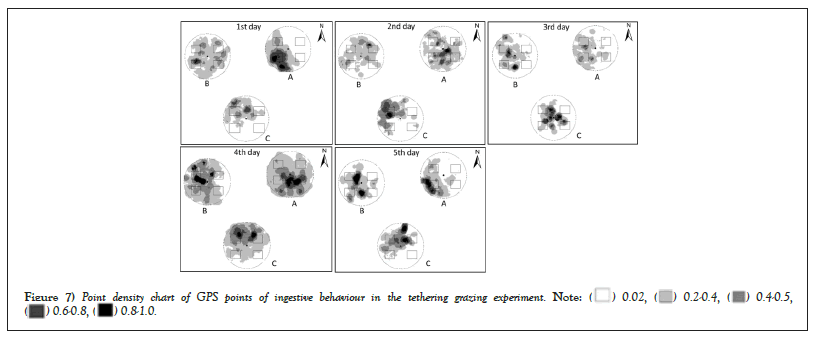
Figure 7: Point density chart of GPS points of ingestive behaviour in the tethering grazing experiment. 

Changes in the soil layer (topsoil) owing to tethering grazing
The daily changes in the values of soil hardness measured in the morning and evening for all four quadrats located at each site were averaged, and the results are shown in Figure 8. The soil hardness varied among the sites, but the soil hardness at sites A and B was almost the same. As a result of the 5-day trampling period of sheep, the soil hardness increased by 1.25 mm and 0.25 mm at sites A and B, respectively. In contrast, site C was a soft sandy soil, and trampling decreased the soil hardness by 0.63 mm.
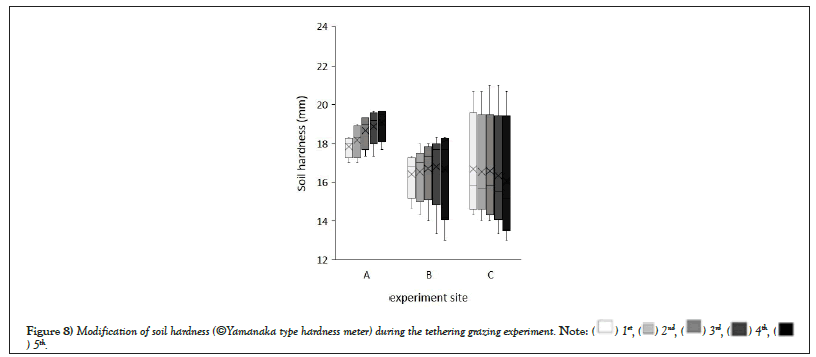
Figure 8: Modification of soil hardness (©Yamanaka type hardness meter) during the tethering grazing experiment. 

This study quantitatively analyzed the ingestive behavior of livestock (sheep), as well as the changes in height, vegetation cover, aboveground biomass, plant species diversity, and topsoil hardness owing to sedentary tethering grazing in a typical pastureland located at Abag Banner in the Xilingol Autonomous Region, Inner Mongolia. Plant height analysis indicated that a short grazing period was sustainable because livestock only consumed softer parts of plants, such as leaf blades and petioles. Furthermore, although grazing reduced the plant height, many plant roots were preserved. Hence, it does not directly negatively impact forage resources.
Regarding plant species diversity, livestock forage selection resulted in the reduction of high palatability species such as A. mongolicum Regel, C. duriuscula C.A. Mey and A. cristatum L., thereby disrupting the distribution of vegetation cover by species in the plant community and reducing the species evenness and diversity of the vegetation cover. Therefore, if continuous grazing were allowed, it would negatively impact those high-palatability species and possibly result in a situation where regeneration is impossible.
Despite prior training to acclimate the three selected sheep to tethering grazing, they were not accustomed to tethering grazing in the new location on the first day of the experiment. The GPS recordings showed that they turned their heads to each other and tried to approach their partners as closely as possible (Figure 7). As they became accustomed to tethering grazing from the second day, they began actively grazing on species with high palatability, such as S. krylovii Roshev., A. mongolicum Regel, C. duriuscula C.A. Mey and A. cristatum L. within reach of the hemp rope tether. Owing to the decrease in species with high palatability, the values of the Shannon diversity index (H') also decreased from day 4, suggesting the reason why sheep were moving and grazing as long as the length of the rope would allow them to reach, almost throughout the site. As the available high-palatability species had decreased, they might have had no choice on the fifth day but to graze on species with low palatability, similar to the first day, to face each other. It was also suggested that the topsoil was degraded by sheep trampling on the second day. The increase in soil hardness was due to sheep trampling, whereas the decrease in soil hardness indicated the destruction of the topsoil (soil layer). Specifically, when the topsoil was destroyed, a sandy horizon beneath it appeared, softening the soil layer and making it more susceptible to being blown away by the wind (Figures 8 and 9).
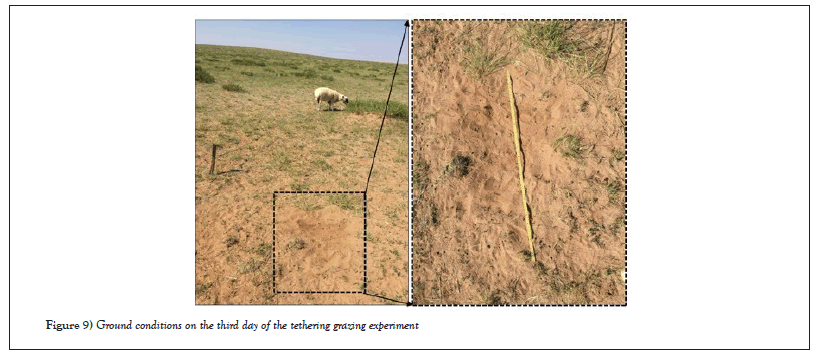
Figure 9: Ground conditions on the third day of the tethering grazing experiment.
Kawada et al., [36,37] showed that small livestock (goats and sheep) preferred A. frigida Willd. to S. krylovii Roshev in Mongolian pastureland. However, our study showed that sheep had similar preferences for S. krylovii Roshev. and A. frigida Willd. S. krylovii Roshev. was the most dominant species and had the highest vegetation cover at our study sites, with a relative foraging rate of 59%, when the relative voluntary intake of A. frigida Willd was 60%.
Grazing disturbance causes qualitative changes and a quantifiable reduction in vegetation. Even on the Inner Mongolian steppe, which is mostly semi-natural pasture land, grazing has had a significant impact on the composition of pastureland vegetation. Although the change in species composition with the progression of degeneration reflects floristic differences among former vegetation pasturelands, there is a commonality in the shift in dominant species from mainly perennial grasses to mainly perennial grasses other than grasses to mainly annual grasses. Nakamura et al., [15] found that L. chinensis, S. grandis, Achnathelum sibiricum, etc. decreased their rank in the community when grazing pressure was increased, while Artemisia frigida, Potentilla aqualis, Carexkorshinskyi, etc. increased their rank. Artemisia frigida, Potentilla aqualis, Carexkorshinskyi, etc., and Koeleria cristata, Potentilla bifurrca, Kochia prostrata, etc., remain unchanged. In other words, a pastureland is in good condition if there are many species, such as L. chinensis and S. grandis.
In pasturelands that have degenerated to an extreme degree owing to overgrazing, transition to a community dominated by annuals of the genus Artemisia (A. sieversiana, A. scoparia), Potentilla acualis, and annuals of the families Acanthaceae and Tetranychaceae, and Setaria viridis (enocograss) has been reported. Moreover, a transition to a community dominated by Setaria viridis (enogamous) has also been reported [7,15,29-32,64-67,74].
Overgrazing has caused serious ecological problems in the dry pasturelands of Inner Mongolia. The high grazing pressure associated with settlement over the past several decades has resulted in the degeneration and desertification of pasturelands, which have become a source of Asian dust storms.
In conclusion, we have quantitatively evaluated the impact of livestock ingestive behavior on a fixed period of time within narrow pasture vegetation in the sedentary grazing area of Inner Mongolia and provided basic data for the sustainable use of pastureland. Climate change has a significant impact on pastureland vegetation, but grazing intensity has also caused changes in the composition of pastureland plant communities and plant species diversity. Long-term sedentary grazing accelerates land degradation, especially around settlement houses, and leads to desertification of pasturelands. We found that livestock feeding behavior resulted in changes in grass height, vegetation cover, aboveground biomass, plant species diversity, and topsoil hardness in grazed areas. However, further grazing experiments with different seasons, livestock compositions, and stocking rates are needed to accurately estimate grazing pressure in pasturelands.
Ethics approval and consent to participate
This study was approved by the Ethics Committee of Rakuno Gakuen University. All responses were coded when conducting a field survey. Respondents' names or other identities were not used to ensure anonymity. With the consent of the owner, Mr. A (the owner of the domestic sheep), we conducted an experiment with three sheep that Mr. A noted had non-destructive device GPS collars attached to the sheep. All procedures using animals were performed in accordance with the Japanese "Law Concerning the Welfare and Management of Animals" (Law No. 105, 1973), the "Standards for the Care and Keeping of Laboratory Animals and the Alleviation of Pain" (Prime Minister's Office Notification No. 6, 1980) and other guidelines regarding animal ethics and animal welfare at Rakuno Gakuen University.
The authors thanks Ms. Khew Ee Hung (Rakunan Gakuen University) and ©Editage (www.editage.jp) for revising the English text of the manuscript and we would like to thank the Lab. of Environmental Remote Sensing, Department of Environmental Sciences at Rakuno Gakuen University for their support of our fieldwork.
TY, HR, and YH participated in data collection. TY MP, and BH designed the study and drafted the manuscript; TY, MP and BH read and approved the final manuscript.
Not applicable in the present context.
This research was supported by Grants-in-Aid for Scientific Research (A) “A Dynamic Analysis of Pastoral Society in Central Asia: From Domestication to Climate Change” (KAKENHI Grant Number: 18H03608) and the JRPLEAD with UKRI joint project "Comparative research on pastoral societies in post-Covid19 Inner Asian countries: case study of Mongolia and Kyrgyzstan (PPIA) and the National University of Mongolia grant P2023-4447 (Leader: Prof. Purevtseren M.).
Tian Ying, Hairihan, and Yong Hai are doctors of environmental remote sensing at the Rakuno Gakuen University, Hokkaido, Japan. Prof. Myagmartseren Purevtseren is a specialist in land management and remote sensing at National University Mongolia. Dr. Buho Hoshino is specialist in remote sensing and satellite tracking of wildlife at Rakuno Gakuen University, Hokkaido, Japan.
[Crossref] [Google Scholar] [PubMed]
[Crossref] [Google Scholar] [PubMed]
[Crossref] [Google Scholar] [PubMed]
[Crossref] [Google Scholar] [PubMed]
[Crossref] [Google Scholar] [PubMed]
[Crossref] [Google Scholar] [PubMed]
[Crossref] [Google Scholar] [PubMed]
[Crossref] [Google Scholar] [PubMed]
[Crossref] [Google Scholar] [PubMed]
[Crossref] [Google Scholar] [PubMed]
[Crossref]
[Crossref] [Google Scholar] [PubMed]
[Crossref] [Google Scholar] [PubMed]
[Crossref] [Google Scholar] [PubMed]
[Crossref] [Google Scholar] [PubMed]
[Crossref] [Google Scholar] [PubMed]
Citation: Ying T, Rihan H, Hai Y, et al. Impact of settlement-type grazing on rangeland vegetation in the Inner Mongolia autonomous region: A field verification of case study through a grazing experiment. AGBIR.2023;39(3):537-546.
Received: 01-Apr-2023, Manuscript No. AGBIR-23-93847; , Pre QC No. AGBIR-23-93847 (PQ); Editor assigned: 04-Apr-2023, Pre QC No. AGBIR-23-93847 (PQ); Reviewed: 18-Apr-2023, QC No. AGBIR-23-93847; Revised: 26-Apr-2023, Manuscript No. AGBIR-23-93847 (R); Published: 03-May-2023, DOI: https://doi.org/10.5281/ zenodo.7964756
Copyright: This open-access article is distributed under the terms of the Creative Commons Attribution Non-Commercial License (CC BY-NC) (http:// creativecommons.org/licenses/by-nc/4.0/), which permits reuse, distribution and reproduction of the article, provided that the original work is properly cited and the reuse is restricted to noncommercial purposes. For commercial reuse, contact reprints@pulsus.com This is an open access article distributed under the terms of the Creative Commons Attribution License, which permits unrestricted use, distribution, and reproduction in any medium, provided the original work is properly cited.
